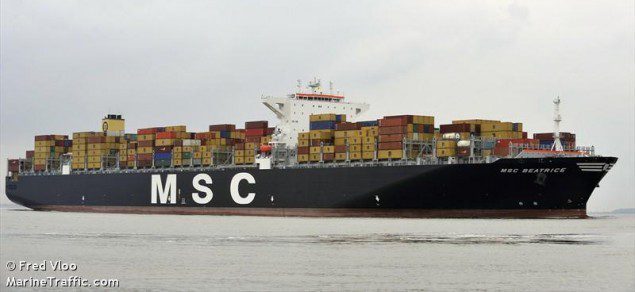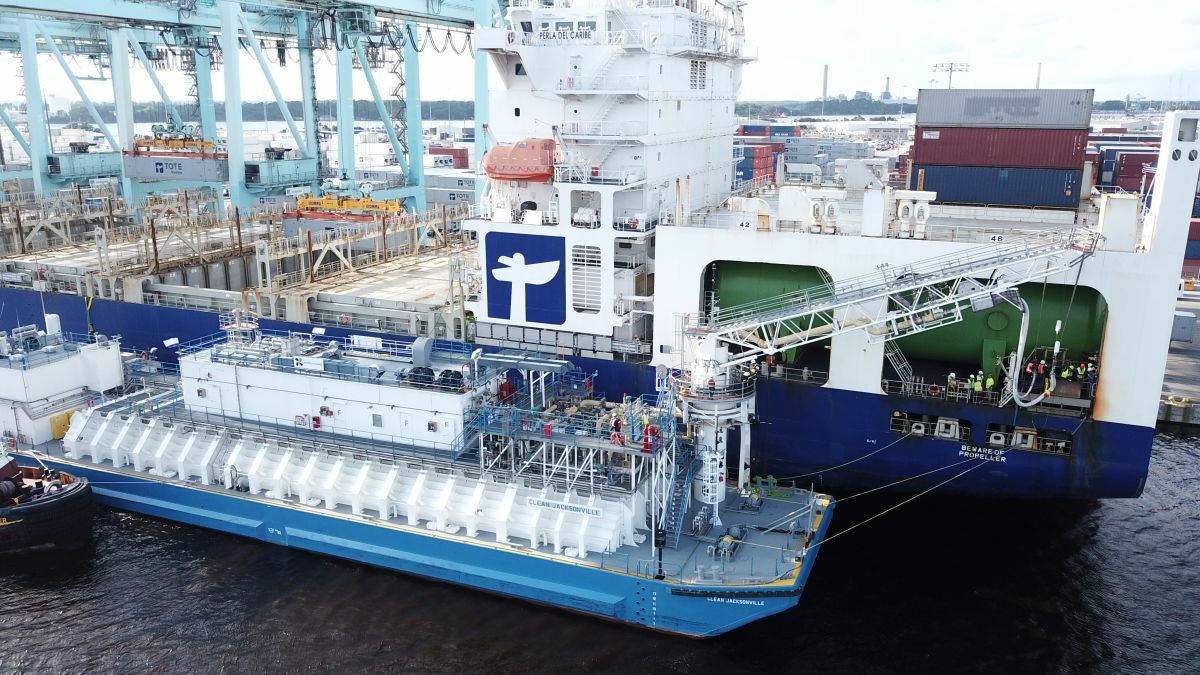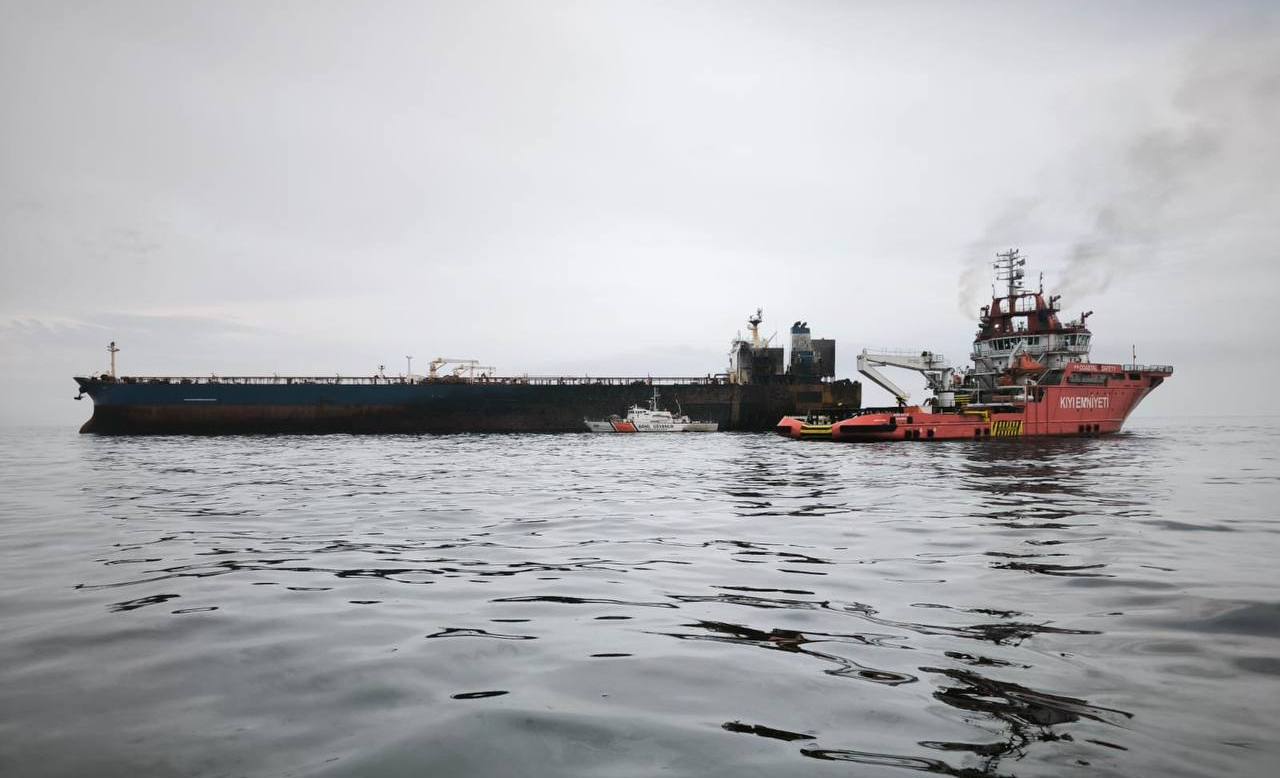(Bloomberg) — Mediterranean Shipping Co., the world’s second-biggest container line, has deployed the largest vessel on a U.S. route in response to swelling demand for goods from Asia.
The MSC Beatrice, a 13,800-box ship, is due to arrive at Long Beach from China on Sept. 26, based on the company’s website. The ship, previously on an Asia-Europe service, replaced an 11,660-container vessel, according to Alphaliner, a shipping-data provider.
Ships transporting containers between the U.S. and Asia are operating at about 95 percent capacity compared with about 80 percent for vessels sailing to Europe from Asia, according to Credit Suisse AG. That’s helped push up rates for U.S.-bound ships while the cost of carrying cargo to Europe has plunged.
“MSC seems to be on an aggressive drive to increase business where things are looking a whole lot better,” said Um Kyung A, an analyst at Shinyoung Securities Co. in Seoul. On Asia-Europe routes, lines “know that unless they cut capacity, they won’t get any rate increases,” she said.
An official at closely-held MSC declined to comment on the reason for the Beatrice’s new route when called by Bloomberg News yesterday. The ship will be used alongside five vessels able to hold from 9,600 to 13,000 boxes on the Long Beach route. Vessels with capacity above 10,000-boxes are generally reserved for Asia-Europe lanes as U.S. ports lack facilities to handle them.
Spot Rates
Geneva-based MSC’s switch comes after Asia-Europe container volumes plunged 13 percent in July, according to Kuehne & Nagel International AG, the world’s largest organizer of sea-freight shipments.
Spot rates to haul 20-foot containers on the trade lane have also fallen 37 percent from this year’s peak in May to $1,218 last week, according to the Shanghai Shipping Exchange. That’s the lowest since the first week of February, when operators began an industrywide push to raise rates. Lines won’t be able to cover costs if rates fall below $1,200, according to Jefferies Group Inc.
Rates may average $1,200 in the fourth quarter, down from an estimated $1,600 in the current quarter, Macquarie Group Ltd. analysts including Bonnie Chan and Corinne Jian said in an Aug. 30 note. The bank expects full-year trade on the route to fall 3 percent compared with an earlier forecast for a 1 percent rise.
‘Weak’ Europe
“Demand from Europe is weak,” said Lawrence Li, an analyst at UOB Kay Hian Holdings Ltd. in Shanghai. “Peak-season demand is totally below expectations.”
The peak season generally runs from about July through October, as retailers stock up for the back-to-school and Christmas shopping seasons.
“Weak demand in Europe could not stabilize the ocean freight rates,” Evergreen Group, Asia’s second-biggest container line, said in an e-mailed reply to Bloomberg News questions. “Trans-Pacific rates have a better outlook.
Macquarie expects a 6 percent jump in full-year trans- Pacific container volumes helped by a recovery in the housing market and better auto sales. Containerized imports by U.S. retailers may jump 8.5 percent this month from last year and by 12 percent next month, according to the Washington-based National Retail Federation.
U.S. Housing
Container rates have risen 12 percent since the first week of May to $2,711 per 40-foot box last week for shipments to the U.S. West Coast from Asia, according to the Shanghai Containerized Freight Index. Lines may have won about 80 percent of targeted rate increases last week, according to Credit Suisse analyst Timothy Ross.
“While Europe’s problems are getting worse, the U.S. economy is showing positive signs of improvement,” Shinyoung’s Um said. “The positive thing for the container business is the recovery we’re seeing in U.S. housing market.”
The National Association of Home Builders/Wells Fargo builder sentiment index, a measure of confidence among U.S. homebuilders, climbed to 40 this month, the highest since June 2006, according to figures from the Washington-based group released on Sept. 18.
While the housing market is showing signs of recovery, the unexpected slowdown in industrial output and retail sales have prompted Norfolk Southern Corp., the second-biggest eastern U.S. railroad, to forecast a third-quarter profit that is lower than analysts’ estimates. The revision follows FedEx Corp. lowering its full-year profit outlook.
Midwest Drought
U.S. railroad profits have been crimped as a drought in the Midwest scorched crops and utilities began using cheaper natural gas for power generation rather than coal carried by rail. Companies such as CSX Corp. and Warren Buffett’s Burlington Northern Santa Fe are bracing for limited increases in pre- holiday shipments because of weak consumer sentiment.
Rail volumes traditionally start to peak in the last two weeks of August as shipments of consumer products bound for store shelves converge with the U.S. harvest and coal for utilities’ winter stockpiles.
Industrial production in U.S. factories, mines and utilities dropped 1.2 percent in August, the most since March 2009. Retail sales, excluding autos and gasoline, rose 0.1 percent in August, less than the forecast, after a 0.8 percent gain in July.
$800 Levy
Still, container lines are gearing up for possible rate increases if dock workers go on strike at ports on the East and Gulf coasts. The International Longshoremen’s Association has said it could vote on a strike from Oct. 1 if negotiations fail to produce a new labor contract. The dispute could affect ports including New York, Boston and Houston.
MSC, China Cosco Holdings Co., China Shipping Container Lines and Hanjin Shipping Co. are all planning a levy of $800 per box if the strike goes ahead. Orient Overseas International Ltd. plans a $600 charge.
The Beatrice is one of 26 ships that can carry 13,800 containers operated by MSC. A.P. Moeller-Maersk A/S, the world’s largest container-ship operator, has eight vessels able to hold as many as 15,500 containers. The Copenhagen-based company has ordered 18,000-box capacity ships that are due to enter service next year.
On Asia-Europe routes, shipping lines plan to cancel 22 sailings during the first two weeks of October when factories in China will be shut for a week-long holiday, according to Alphaliner. That will cut as much as 27 percent of the weekly services, it said. The reduction is bigger than usual for the annual holiday, according to Johnson Leung, head of transport at Jefferies in Hong Kong.
The G6 Alliance, whose members include Neptune Orient’s APL Ltd. and Orient Overseas, will also halt one of six weekly Asia- Europe services next month. The CKYH alliance, which includes China Cosco and Hanjin Shipping, will also cut one of its five Asia-Europe services.
“It’s showing the environment is more challenging,” Leung said. “It also shows the industry is being proactive. They don’t want another year of losses.”
– Kyunghee Park and Alexandra Ho with assistance from Yu-huay Sun in Taipei, Alex Webb in Frankfurt and Dylan Griffiths in Geneva. Copyright 2012 Bloomberg

 Join The Club
Join The Club












